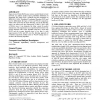Free Online Productivity Tools
i2Speak
i2Symbol
i2OCR
iTex2Img
iWeb2Print
iWeb2Shot
i2Type
iPdf2Split
iPdf2Merge
i2Bopomofo
i2Arabic
i2Style
i2Image
i2PDF
iLatex2Rtf
Sci2ools
WWW
2008
ACM
2008
ACM
Rogue access point detection using segmental TCP jitter
Rogue Access Points (RAPs) pose serious security threats to local networks. An analytic model of prior probability distribution of Segmental TCP Jitter (STJ) is deduced from the mechanism of IEEE 802.11 MAC Distributed Coordinated Function (DCF) and used to differentiate the types of wire and WLAN connections which is the crucial step for RAPs detecting. STJ as the detecting metric can reflect more the characteristic of 802.11 MAC than ACK-Pair since it can eliminate the delay caused by packet transmission. The experiment on an operated network shows the average detection ratio of the algorithm with STJ is more than 92.8% and the average detection time is less than 1s with improvement of 20% and 60% over the detecting approach of ACK-Pair respectively. Farther more no WLAN training trace is needed in the detecting algorithm. Categories and Subject Descriptors C.2.3 [Network Operations]: Network management and monitoring General Terms Management, Measurement Keywords Rogue AP, Segmenta...
| Added | 21 Nov 2009 |
| Updated | 21 Nov 2009 |
| Type | Conference |
| Year | 2008 |
| Where | WWW |
| Authors | Gaogang Xie, Tingting He, Guangxing Zhang |
Comments (0)

